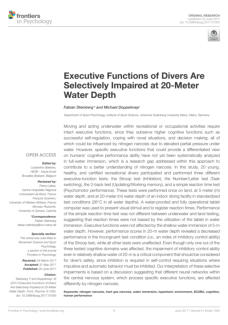Scientific papers 2017





This article describes the various dermatoses that can be
contracted during occupational and recreational diving.
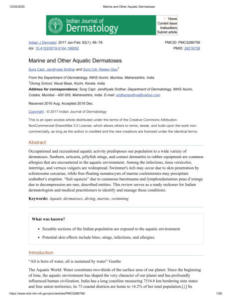

This study aimed to compare two decompression
procedures commonly adopted by technical divers:
The ZH-L16 algorithm, modified by 30/85 gradient factors
(compartmental decompression model, CDM) versus the
‘ratio decompression strategy’ (RDS).
The comparison was based on an analysis of changes in
diver circulating inflammatory profiles caused by
decompression from a single dive.
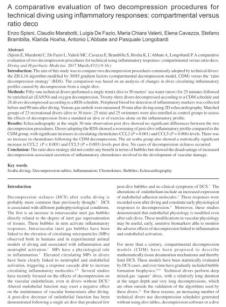

Authors:
Thijs T. Wingelaar, Pieter-Jan A. M. van Ooij, and Rob A.
van Hulst.
In Special Operations Forces (SOF) closed-circuit
rebreathers with 100% oxygen are commonly utilized for
covert diving operations. Exposure to high partial
pressures of oxygen (PO2) could cause damage to the
central nervous system (CNS) and pulmonary
system. Longer exposure time and higher PO2 lead to
faster development of more serious pathology.
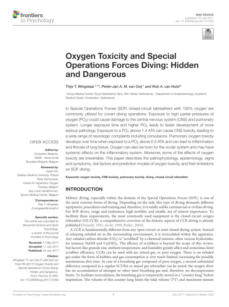

Authors:
István Vadász & Jacob I. Sznajder
This review discusses recent discoveries on the sensing
and signaling events initiated by hypoxia and hypercapnia
and the relevance of these results in the identification of
potential novel therapeutic targets in the treatment of
acute respiratory distress syndrome (ARDS).
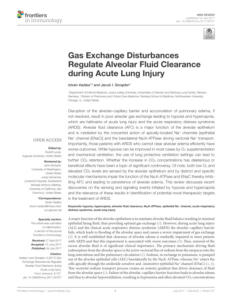

Authors: Pierre Lafère, Costantino Balestra, Dirk Caers,
Peter Germonpré.
The authors have crossed information from Belgian
Hyperbaric Centers, DAN. Emergency Hotline, the press,
and Internet diving forums to consider the majority of
decompression sickness (DCS) occurred in Belgium from
January 1993 to June 2013. From the available 594
records, the authors excluded all cases with tentative
diagnosis, medullary DCS, or unreliability of reported dive
profile, leaving 209 divers records with cerebral DCS for
analysis. Dive parameters and patent foramen ovale (PFO)
were recorded. Twenty-three injured divers were tested
using the Zuckerman’s Sensation Seeking Scale V and
compared to a matched group not involved in risky
activities.


Authors:
Peter Germonpré, Costantino Balestra, Walter Hemelryck,
Peter Buzzacott, Pierre Lafère.
This double-blinded, randomized trial was designed to see
if using Enriched Air Nitrox (EANx) could improve
cognitive performance while diving. Eight volunteers
performed two no-decompression dry dives breathing air
or EANx for 20 min at 0.4 MPa. Their cognitive functions
were assessed with a computerized test battery.
Measurements were taken before the dive, upon arrival,
after 15 min at depth, upon surfacing, and at 30 min
postdive. After each dive, subjects were asked to identify
the gas they had just breathed..

Authors:
Danilo Cialoni, Massimo Pieri, Costantino Balestra,
Alessandro Marroni
The popularity of SCUBA diving is steadily increasing,
together with the number of dives and correlated
diseases per year. The rules that govern correct
decompression procedures are considered well known
even if the majority of Decompression Sickness (DCS)
cases are considered unexpected, confirming a bias in the
“mathematical ability” to predict DCS by the current
algorithms. Furthermore, little is still known about diving
risk factors and any individual predisposition to DCS. This
study provides an in-depth epidemiological analysis of the
diving community to includeadditional risk factors
correlated with circulating bubbles and DCS
development.


Authors:
Heather Massey, John Leach, Michael Davis, & Vicki
Vertongen.
In most countries, immersion represents the second most
common cause of accidental death in children and the
third in adults. Between 2010 and 2013, 561 deaths
worldwide involving recreational divers were recorded by
the Divers Alert Network. Consequently, there is no room
for complacency when diving. Being lost at sea is a diver’s
worst nightmare. In 2006, a diver was lost at sea off the
coast of New Zealand for 75 hours. It is unprecedented
that, after such a long time immersed in temperate
(16−17 ° C) waters, he was found and survived. His case is
presented and utilized to illustrate the many physiological
and psychological factors involved in prolonged
immersion and what might determine survival under
such circumstances. The authors also briefly review
options for enhancing diver location at sea, and a few
issues related to search and rescue operations are
discussed.
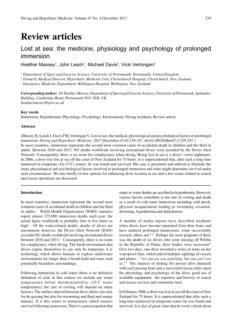

Authors:
Anne-Kathrin Brebeck, Andreas Deussen, Henning
Schmitz-Peiffer, Ursula Ranged, Costantino Balestra, Sinclair
Cleveland, and Jochen D. Schipke.
This study compares the effects of nitrox28 and air on two
psychometric tests. In this double-blind, open-water study,
108 advanced divers were randomized to air or a nitrox
group for a 60-min dive to 24 m saltwater. Breathing gas
effects on cognitive performances were assessed during
the dive using a short and long-term memory test and a
number connection test.



Authors:
Alvhild Alette Bjørkum, Eystein Oveland, Linda Stuhr,
Marianne Bjordal Havnes, Frode Berven, Marit Grønning,
Arvid Hope.
The main objective of the present study was to determine
the effects on the brain proteome of fast decompression
(1 bar/20 s) compared to controls (1 bar/10 min) after
heliox saturation diving, using rats in a model system.
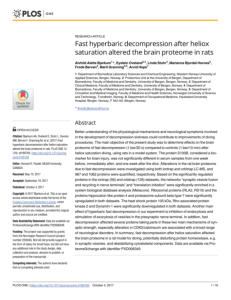

Authors: Shopov Nikola, VazharovIvaylo.
The most likely factor initiating Decompression Sickness
(DCS) is believed to be the formation of bubbles in the
blood and the tissues. Bubbles form during
decompression due to supersaturation of the dissolved
gas from the gas nuclei present in the tissues even at
normal atmospheric pressure and provoke the symptoms
of DCS. Ascent rate is known to be a critical factor for DCS
risk. Individual factors, such as age, weight, and fat tissues,
are also recognized for their implication in DCS risk. This
study aimed to contribute to enhanced safety of divers by
measuring the rate of off-gassing utilizing Doppler after
decompression and relating it to ascent rate and some
individual factors.
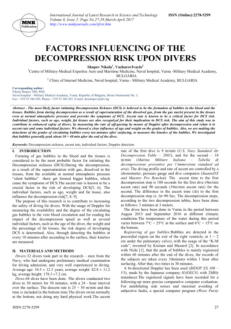

Authors: Seol-Jung Kang, Gi-Chul Ha, & Kwang-Jun Ko.
The present study aimed to investigate the association
between metabolic syndrome and cardiorespiratory
fitness according to the resting heart rate of Korean male
adults..
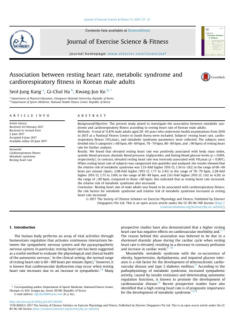

Authors: Peter Germonpré & Costantino Balestra.
Vascular gas emboli (VGE) are observed after
asymptomatic scuba dives and are considered a key
element in the potential development of decompression
sickness (DCS). Diving is also accompanied by vascular
dysfunction, as measured by flow-mediated dilation
(FMD). Previous studies showed significant intersubject
variability to VGE for the same diving exposure and
demonstrated that VGE could be reduced with even a
single pre-dive intervention. Several preconditioning
methods have been reported recently, seemingly acting
either on VGE quantity or inflammatory endothelial
markers.
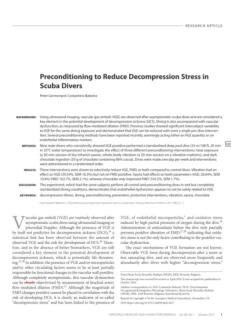

Authors: C. Walsh, N. Ovenden, E. Stride, & U. Cheemat.
Understanding cell-bubble interactions is crucial for
preventing bubble related pathologies and harnessing
their potential therapeutic benefits. Bubbles can occur in
the body as a result of therapeutic intravenous
administration, surgery, infections or decompression.
Subsequent interactions with living cells, may result in
pathological responses such as decompression sickness
(DCS). This work investigates the interactions that occur
between bubbles formed during decompression and cells
in a 3D engineered tissue phantom.


Author: Ran Arieli
It is known that nanobubbles form spontaneously when a
smooth hydrophobic surface is submerged in water
containing dissolved gas. These nanobubbles may be the
long-sought-after gas micronuclei underlying
decompression bubbles and DCI. The authors exposed
hydrophobic and hydrophilic silicon wafers underwater to
hyperbaric pressure. After decompression, bubbles
appeared on the hydrophobic but not the hydrophilic
wafers. In further experiments, the authors placed sizeable
ovine blood vessels in a cooled high-pressure chamber at
1,000 kPa for about 20 h.
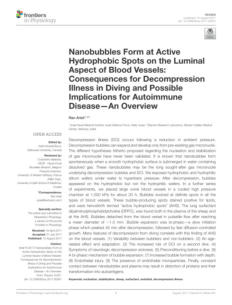

Authors: Br Vienke & T O’ Leary
This short monogram details dive computers, operation,
protocols, models, data, tests, risk and coupled
applications.
Basic diving principles are detailed with practical
computer implementations. Topics are related to diving
protocols and operational procedures. Tests and
correlations of computer models with data are
underscored. The exposition also links phase mechanics
to decompression theory with equations used in
computer syntheses.


Authors:
Long Qing, Dinesh K. Ariyadewa, Hongjie Yi , Yewei
Wang, Quan Zhou, and Weigang Xu.
Skin lesions are visual clinical manifestations of
decompression sickness (DCS).
Comprehensive knowledge of skin lesions would give
simple but strong clinical evidence to help diagnose DCS.
The aim of this study was to systematically depict skin
lesions and explore their pathophysiological basis in a
swine DCS model.
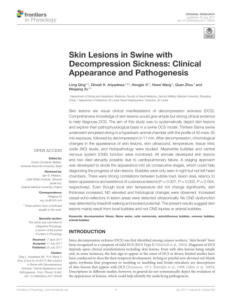

Authors:
Dor Vadas , Leonid Kalichman, Amir Hadanny , and Shai
Efrati
The Brain uses 20% of the total oxygen supply consumed
by the entire body. Even though, < 10% of the brain is
active at any given time, it utilizes almost all the oxygen
delivered. In order to perform complex tasks or more than
one task (multitasking), the oxygen supply is shifted from
one brain region to another, via blood perfusion
modulation. The aim of the present study was to evaluate
whether a hyperbaric oxygen (HBO) environment, with
increased oxygen supply to the brain, will enhance the
performance of complex and/or multiple activities.


Authors:
Daniel Mathieu, Alessandro Marroni and Jacek Kot
The tenth European Consensus Conference on
Hyperbaric Medicine took place in April 2016, attended by
a large delegation of experts from Europe and elsewhere.
The focus of the meeting was the revision of the
European Committee on Hyperbaric Medicine (ECHM) list
of accepted indications for hyperbaric oxygen treatment
(HBOT), based on a thorough review of the best available
research and evidence-based medicine (EBM)
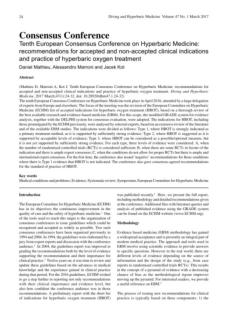

Author: Barbara Shykoff
This text has been published on the Shearwater website in
May 2017
https://www.shearwater.com/
Direct link: https://www.shearwater.com/monthly-blog-
posts/uptd-calculations-not-used/


Authors:
Charles H. Van Wijk, Jarred H. Martin, Willem A.J. Meintjes
This paper considers the relationship between measures
of personality and mood states and susceptibility to inert
gas narcosis. It briefly reviews the topics of inert gas
narcosis affecting personality and personality affecting the
susceptibility to inert gas narcosis. There appears to be a
theoretical argument for a possible relationship between
measures of personality, mood states, and susceptibility to
narcosis. Practically, such a relationship may speak to
selection, training and preparation issues, risk assessments,
and even accident investigation in the diving and/or
hyperbaric environment.
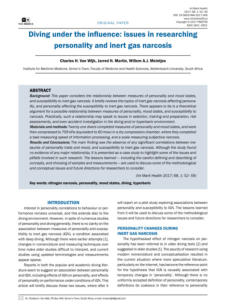

Authors:
Sara Farshchi Zarabi, Matteo Parotto, Rita Katznelson,
James Downar
Air embolism into the systemic arterial circulation
secondary to pulmonary barotrauma has rarely been
reported. Herein, we report the clinical course of an
extremely rare presentation of cerebral air embolism likely
due to ruptured pulmonary bullae during commercial air
travel.
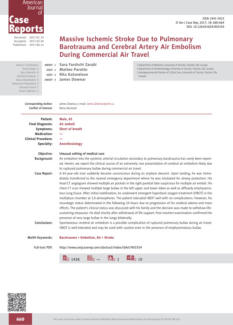

Authors:
Moritz F Meyer, Manuela Boor, Stefanie Jansen, Eberhard
D Pracht , Moritz Felsch, Heinz D Klünter, Karl-Bernd
Hüttenbrink, Dirk Beutner, Maria Grosheva
In a prospective, observational trial, the authors
investigated the feasibility of using the Eustachian tube
function test (ETFT) to measure the effect of repetitive
pressure exposure during open seawater dives on
Eustachian tube function.


Authors:
Moritz F Meyer, Manuela Boor, Stefanie Jansen, Eberhard
D Pracht , Moritz Felsch, Heinz D Klünter, Karl-Bernd
Hüttenbrink, Dirk Beutner, Maria Grosheva
In a prospective, observational trial, the authors
investigated the feasibility of using the Eustachian tube
function test (ETFT) to measure the effect of repetitive
pressure exposure during freshwater dives on Eustachian
tube function.
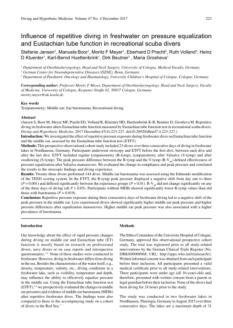

Authors: Mark J Elder, John A Rawstron, Michael Davis
Acute Retinal Artery Occlusion (ARAO) is a significant
cause of sudden, painless visual loss, often leaving no
useful vision in the affected eye. Its incidence is cited at
0.85 per 100,000 persons per year but may be higher
because of under-reporting. The natural history is difficult
to study, but a spontaneous resolution rate of < 1–8% for
acute, non-arteritic ARAO has been cited. There is
currently no consensus regarding the management of
ARAO and little evidence to support any treatment
modality. Despite only a limited case series, hyperbaric
oxygen treatment (HBOT) is recommended for ARAO by
the Undersea and Hyperbaric Medical Society (UHMS)
and the European Committee for Hyperbaric Medicine.
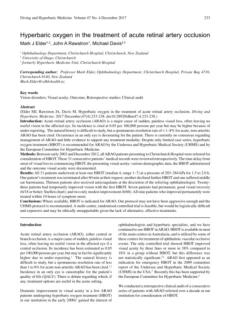

Author: Charles H Van Wijk
This paper provides a brief overview of the shift from
studies describing the personality profiles of divers to
studies exploring associations between personality
variables and diving performance in terms of behavioural
outcomes.


Author: Abraham L Querido
Psychoactive drugs pose a risk to both the diver and his or
her buddy. Little is known about the safety of diving with
antidepressants. Amongst the potential interactions with
the diving environment are: somnolence; convulsions; a
bleeding tendency (potentially worsening decompression
illness, DCI), alterations to glucose metabolism and
psychiatric side effects. Fluoxetine may potentially reduce
the inflammatory process associated with DCI. This article
presents guidelines for recreational diving in combination
with antidepressants.


Author: Michael FM Perez, Janet V Ongkeko-Perez, April R
Serrano, Maravic P Andal, Maria CC Aldover
Arterial gas embolism is a catastrophic event. Bubbles in
the arterial circulation may lodge in the brain and cause
infarction in the affected area and/or in a coronary vessel
causing acute myocardial ischaemia. There is no well-
defined window of time beyond which a response to
hyperbaric oxygen is not expected. Major improvement
may occur if the patient is treated as soon as possible, but
is less likely in divers with severe decompression illness
who have delayed intervention. We report on a 51-year-
old, male rebreather diver who suffered loss of
consciousness and cardiovascular collapse within minutes
of a 30-metre deep dive at a remote Micronesian dive site.
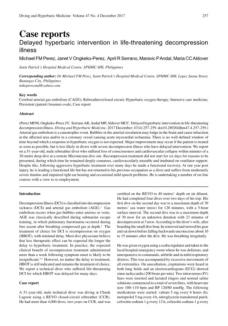

Author: Jordan M Warchol, Jeffrey S Cooper, Thomas S
Diesing
Oxygen toxicity seizures are a well-known complication of
hyperbaric oxygen treatment (HBOT). Until now, there
have not been any reported cases of an acute ischaemic
event (stroke) as the result of a HBOT-associated oxygen
toxicity seizure.
This document reports an event in which a seizure and
stroke occurred together and consider that the stroke
may have been caused by seizure-induced demand
ischaemia.
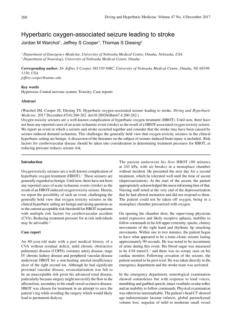

Author: Lu Shi, Yan-meng Zhang, Katsuura Tetsuo,
Zhong-yuan Shi, Yi-qun Fang, Petar J. Denoble,
Yang-yang Li
Experience with commercial heliox diving at high altitude
is limited. The purpose of this study was to evaluate the
effects of acute high-altitude exposure on fitness to dive
and the safety of decompression after heliox diving while
using U.S. Navy heliox decompression tables with Cross
correction.
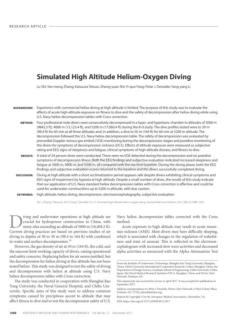

Authors:
W. Oliver Tobin, Sean J. Pittock
This article reviews the rapidly evolving spectrum of
autoimmune neurologic disorders with a focus on those
that involve the central nervous system, providing an
understanding of how to approach the
diagnostic workup of patients presenting with central
nervous system symptoms or signs that could be immune
mediated, either paraneoplastic or idiopathic, to guide
therapeutic decision making.
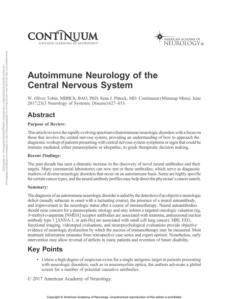


Click on the octopus
to return to the top
of the page



Author: Andreas Fahlman
A probabilistic model was used to predict the outcome of
decompression sickness (DCS) in pigs (70 and 20 kg),
hamsters (100 g), rats (220 g), and mice (20 g) following
air-saturated dives.
The final model accurately predicted 58 out of 61 dive
profiles for pigs, hamsters, rats, and mice. Body mass
helped improve the prediction of DCS risk in four
mammalian species across a body mass range spanning
three orders of magnitude.


Authors:
Kate Lambrechts, Costantino Balestra, Michaël Theron,
Anne Henckes, Hubert Galinat, Fanny Mignant, Marc
Belhomme, Jean-Michel Pontier, François Guerrero
The authors of this study aimed to evaluate the effect of
bubble formation on vascular function and hemostasis. To
achieve this, they used vibration preconditioning to
influence bubble levels without altering other parameters
associated with the dive.
The results suggest that macrovascular impairment, but
not microvascular impairment, is at least partly due to
bubbles, possibly related to platelet activation and the
generation of procoagulant microparticles.
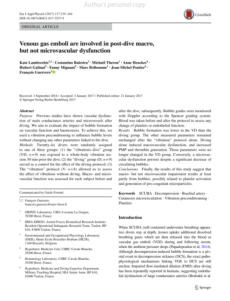

Authors: Laurens E. Howle, Paul W. Weber, Ethan A.
Hada, Richard D. Vann, and Petar J. Denoble
This study analyzed 3322 cases of air and N2-O2 dives,
which included 190 cases of decompression sickness
(DCS). These were categorized into serious and mild types
using U.S. Navy medical standards. Researchers developed
a three-state model to predict the likelihood of mild and
serious DCS from dive exposure. This model showed a
significant improvement over the two-state model.
Applying the Type I/II definition, longer bottom times are
permitted for a 2% mild DCS risk, but a significant
decrease in allowable bottom time is observed for serious
DCS at a 0.1% risk.
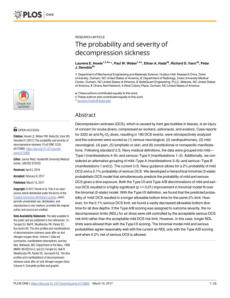

Author: Amy E. King, F. Gregory Murphy, Laurens E.
Howle
This study analyzed research dive trial data from the
BIG292 dataset, a primary U.S. Navy model calibration set.
Occurrence Density Functions (ODFs) were used to
visualize DCS symptom onset rates over time.
The study illuminates the complexities of DCS onset times
and highlights the need for accurate symptom timing in
diving safety protocols.
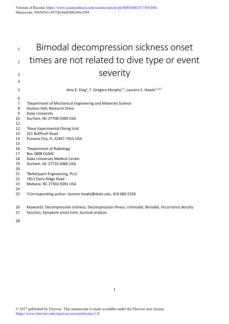

Authors: B.R. Wienke, T.R. O’Leary
Dive computers and diveware are increasingly replacing
traditional dive tables due to their crucial role in various
diving sectors, including sports, technical, and military
diving. .
This paper discusses two fundamental biophysical
models—oxygen toxicity and risk estimators—that can be
integrated into current dive computers and software to
assess end-of-dive and on-the-fly (OTF) risks. The study
provides comparative results for various diving scenarios
implementing these methodologies into existing platforms
and aims to enhance safety measures in the diving
industry.
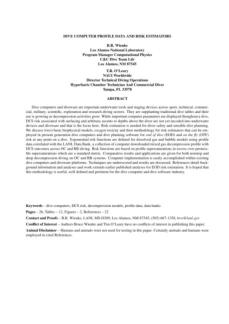

Authors: Krzysztof Korzeniewski, Jarosław Krzyzak
The authors present this study by stating that since the
majority of popular recreational dive sites are located in
tropical or subtropical destinations, generally
characterized by harsh climates and poor sanitation,
recreational divers who are not accustomed to these
areas should take preventive measures to reduce health
risks. It can be assumed that some of the
recommendations in this document will also apply to
commercial divers who are not accustomed to working in
these areas.
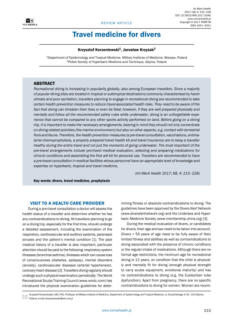

Authors: Lu Shi, Yan-meng Zhang, Katsuura Tetsuo,
Zhong-yuan Shi, Yi-qun Fang, Petar J. Denoble,
Yang-yang Li
The purpose of this study was to evaluate the effects of
acute high-altitude exposure on diving fitness and
decompression safety after heliox diving using U.S. Navy
heliox decompression tables with cross-correction.
Decompression safety was assessed by precordial Doppler
venous gas embolism (VGE) monitoring during
decompression and by post-dive monitoring of divers for
symptoms of decompression sickness (DCS).
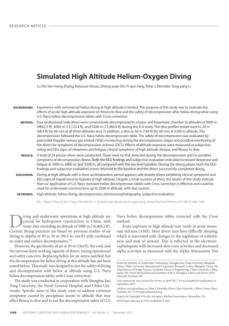



Author: Claire Walsh
This paper describes research on the formation and
dynamics of bubbles in the body due to ambient pressure
changes, which are linked to decompression sickness
(DCS). The author outlines the use of an in vitro matrix
model (collagen type I gel) to validate and further develop
a 3D computational model of extravascular bubble
dynamics and discusses the challenges in validating dive
computer algorithms that incorporate mechanistic bubble
models, the necessity of direct bubble observation, and
the potential of biomimetic in vitro models to address
these challenges.
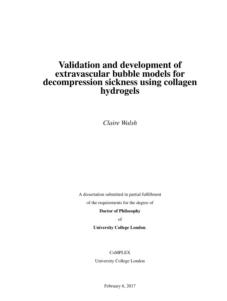

Author: Yun Jung Oh, Ji Yong Jung, Sung Soo Kim,
Kyong-Suk Chae, Jiwon Rhu, & Chungsik Lee
This study investigates the long-term effects of repetitive
breath-hold diving (BHD) on kidney function. Using a
cross-sectional propensity score-matched analysis, it
specifically examines the prevalence of chronic kidney
disease (CKD) among female breath-hold divers
compared to non-divers. The results indicate that breath-
hold divers have a significantly higher prevalence of CKD,
suggesting that repetitive apnea associated with BHD
may lead to kidney dysfunction over time.
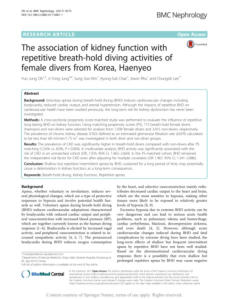

Authors: Kun Zhang, Mengmeng Wang, Haowen Wang,
Yinuo Liu Peter Buzzacott, & Weigang Xu
This paper presents the findings of a scientific study
investigating the relationship between decompression
stress, endothelial injury, and bubble formation in rats to
understand the time course of endothelial injury and its
correlation with bubble amounts following
decompression. The authors detail the methodology,
including the simulated air dive, the detection of bubbles,
and the measurement of specific biomarkers (MDA, ET-1,
ICAM-1). They conclude that endothelial dysfunction
correlates with bubble counts and that these biomarkers
can serve as sensitive parameters for assessing bubble
load and decompression stress


Author: Ran Arieli & Abraham Marmur
The authors of this document present a new biophysical
model for understanding and predicting the formation
and behavior of vascular bubbles during decompression,
which is relevant for improving diver decompression
procedures. They discuss the mechanisms of bubble
formation and expansion, the role of active hydrophobic
spots, the factors influencing bubble dynamics, and
propose a model that aligns more closely with
physiological processes by offering better predictability for
decompression illness.
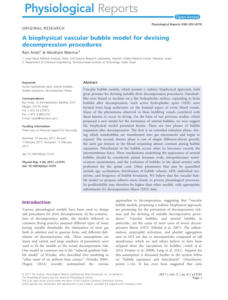

Authors: Surg Capt D K Ghosha, Surg Cdr C Kodangeb,
Surg Cdr C S Mohanty, Surg Cdr Rohit Vermad
This study focuses on the incidence and management of
diving-related injuries such as Decompression Sickness
(DCS) and Pulmonary Overinflation Syndrome (POIS) with
the purpose of informing on the causes, prevention, and
treatment of these conditions, highlighting the low
incidence of such injuries among navy divers due to strict
adherence to safety procedures and rigorous training.
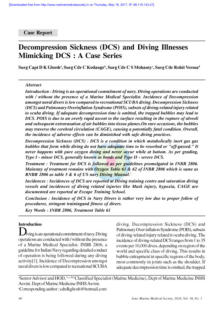

Authors: S. Lesley Blogg, Andreas Møllerløkken, Mikael
Gennser
This article discusses the results of a retrospective analysis
of post-dive bubbling and DCS incidents from seven
studies, using a particular dive profile. It evaluates the
safety of this dive profile by comparing observed DCS
incidents and bubble measurements with predicted
models and historical data.
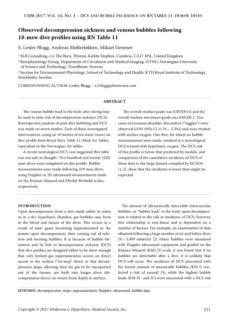

Authors: Ilaria Marrocco, Fabio Altieri, and Ilaria Peluso
This document discusses the challenges and biases
associated with the methods used to evaluate oxidative
stress in humans. It highlights the lack of consensus on the
validation, standardization, and reproducibility of these
methods and suggests that using a combination of
markers could provide a more comprehensive assessment
of oxidative stress. Its authors also emphasize the
importance of selecting appropriate markers based on the
study's objectives and the clinical relevance to the subjects
involved.
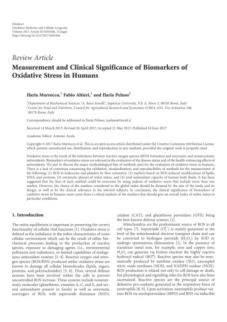

Authors: Ed O’Brien , Giorgio Caramanna
This study focused on analyzing human factors in scientific
diving, particularly during training dives by professional
divers. It aims to address individual variability in human
factors and their impact on teamwork while also
highlighting the dual nature of human involvement in
diving as both a strength and a potential source of error. It
also shares preliminary findings regarding commonalities
and correlations between stressors and human
performance among team members.

Authors:
Alvhild Alette Bjørkum, Eystein Oveland, Linda Stuhr,
Marianne Bjordal Havnes, Frode Berven, Marit Grønning,
Arvid Hope.
The main objective of the present study was to determine
the effects on the brain proteome of fast decompression
(1 bar/20 s) compared to controls (1 bar/10 min) after
heliox saturation diving, using rats in a model system.
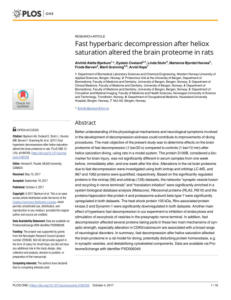
Authors: John Lippmann, David McD Taylor, Christopher
Stevenson, Jo Williams, Simon J Mitchell
This paper is a survey conducted by the Divers Alert
Network Asia-Pacific (DAN AP) on divers with
cardiovascular, respiratory conditions, and diabetes to
analyze how these divers manage their medical
conditions, any modifications they make to their diving
practices to mitigate risks, and the outcomes of these
practices. It also discusses the methodology of the survey,
the results obtained, and the conclusions drawn
regarding the safety and risk management of diving with
pre-existing health conditions.

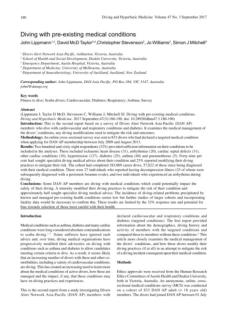

Author: Frédéric Beneton, Guillaume Michoud, Mathieu
Coulange, Nicolas Laine, Céline Ramdani, Marc
Borgnetta, Patricia Breton, Regis Guieu, J. C.
Rostain, and Marion Trousselard
This study evaluates the benefits of scuba diving on
perceived stress and mindful functioning to compare the
effects of scuba diving with other recreational sports on
stress reduction, mood improvement, and mindfulness. It
concludes that recreational diving has greater health
benefits in reducing stress and improving well-being
compared to other sports.
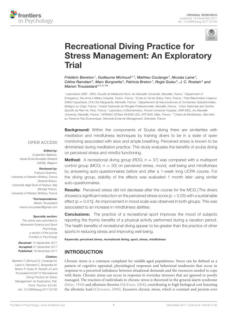



1 - Physical and physiological aspects of submarine tower escape

Author: Geoff A.M. Loveman
This work focused on studying submarine escape and
rescue issues, using animal experiments with goats and
human trials. Its author developed mathematical models
to predict equipment performance and decompression
effects and contributed to over sixty reports for the UK
Ministry of Defence. His research supports the use of
surface oxygen for treating decompression illness and has
led to changes in escape policy accepted by the UK Royal
Navy and being part of NATO guidelines.
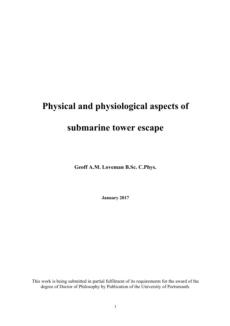



09 - A comparative evaluation of two decompression procedures for
technical diving using inflammatory responses: compartmental
versus ratio deco.

Authors: Enzo Spisni, Claudio Marabotti, Luigia De Fazio,
Maria Chiara Valerii, Elena Cavazza, Stefano
Brambilla, Klarida Hoxha, Antonio L’Abbate and
Pasquale Longobardi
This study compared two decompression methods used
by technical divers: the ZH-L16 algorithm with modified
gradient factors (CDM) and the ratio decompression
strategy (RDS). Fifty-one divers completed a single trimix
dive followed by different decompression schedules.
Results showed no significant differences in bubbles
between the methods, but RDS increased inflammatory
markers, indicating a higher risk of vascular damage
compared to CDM. No decompression sickness cases
were reported.
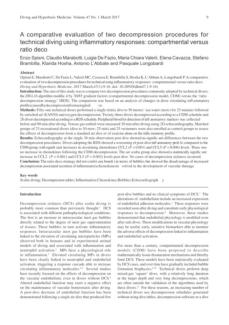



24 - A technical diving-related burns case: treatment in a remote
location

Authors: Fiona C Sharp, Martin DJ Sayer
Injuries from a rebreather oxygen explosion and fire
affected a diver on vacation in Chuuk, Micronesia. The
management of the diver's care in a remote area is
described. The causes of the fire and the resulting injuries
are discussed. Prevention and preparation for such
incidents are highlighted due to the growing popularity
of diving and adventure travel to remote locations.




31 - Reliability of Right-to-Left Shunt screening in the prevention of
Scuba diving related-decompression sickness.

Author: James Bell, Paul A. Thombs, William J. Davison,
Lindell K. Weaver
This study investigated how right-to-left shunt (RLS) relates
to decompression sickness (DCS) in scuba divers and
whether screening for RLS is beneficial for prevention. It
compared 634 injured divers with 259 healthy divers,
finding higher RLS rates in those with certain types of DCS.
Increased RLS size raised DCS risk, but screening is not
recommended for routine practice.
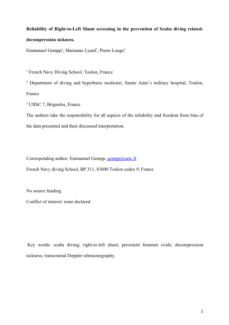



23 - Executive Functions of Divers Are Selectively Impaired at 20-
Meter Water Depth

Authors: Fabian Steinberg, and Michael Doppelmayr
This study analyzed executive functions in recreational
and occupational activities underwater, focusing on
nitrogen narcosis. The researchers found that nitrogen
narcosis can affect self-regulation, coping with new
situations, and decision-making abilities. The study
involved 20 young, healthy, and certified divers who
performed three tests: Stroop, Number/Letter, 2-back,
and a simple reaction time test. Results showed no
difference in performance between underwater and
land testing. However, in 20-meter water depth, the
Stroop test showed decreased performance, indicating a
potential impairment in inhibitory control ability. This is
crucial for diver safety, as inhibition is essential for self-
control.
